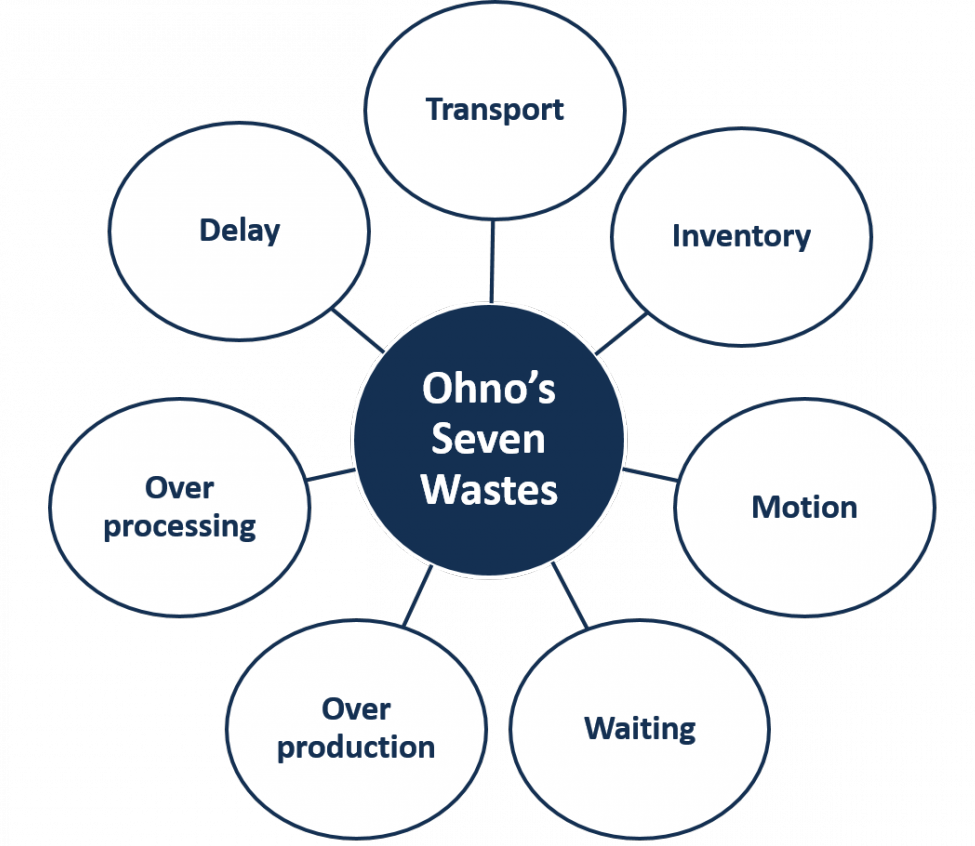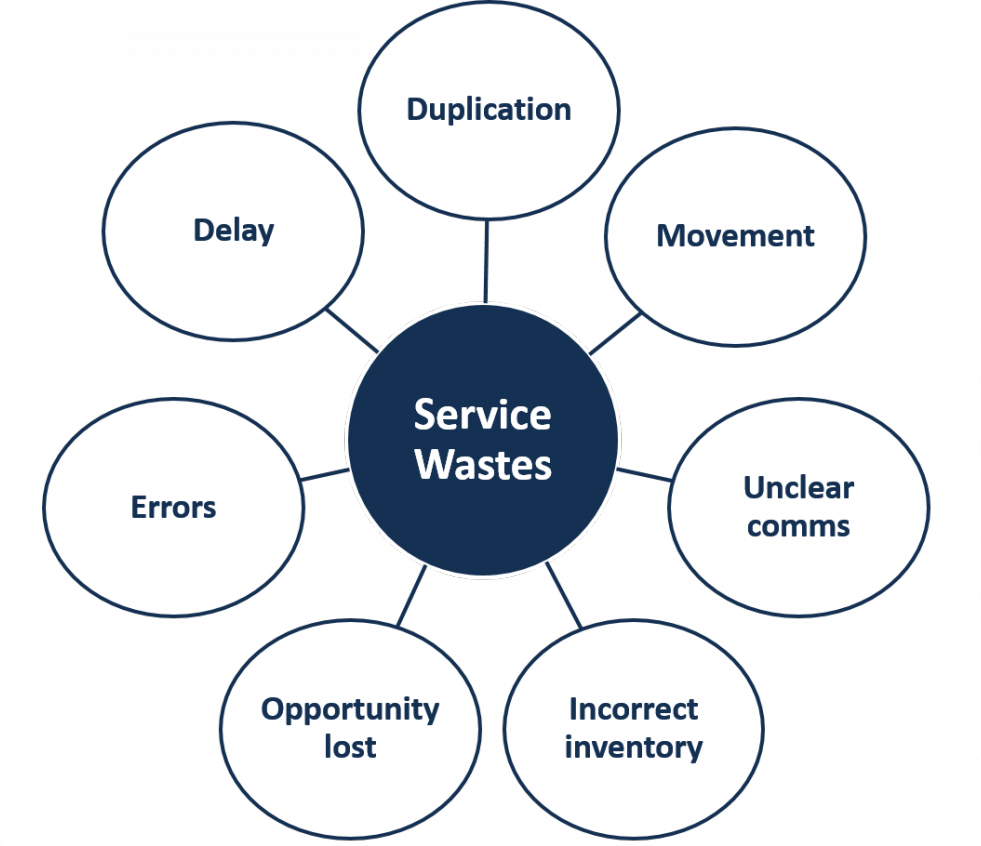
From the Seven Wastes to the Multiple Wastes of Lean Thinking.
The Original Wastes
Taiichi Ohno famously identified the Seven Wastes of the Toyota Production System that have become part of the bedrock of lean knowledge and fundamental to lean improvement initiatives. Acronyms such as TIMWOOD regularly appear in handbooks and courses as useful ways to remember what they are: see Figure 1.
The Addition
However, many practitioners and organisations have added an eighth waste to Ohno’s original list, relating broadly to untapped human potential or some similar wording connecting to the notion that if you don’t maximise the contribution of employees and motivate them to excel, then this is ‘waste’ or at least opportunity lost. This often manifests itself in waste lists as:
- Non-utilised talent; under utilising peoples skills, talent and knowledge
- Not engaging all
- Intellect – not using employees intellectual contribution
- Mind (this allows an extra M in TIMMWOOD so it remains an acronym!)
- Skills – Under utilising capabilities, delegating tasks with inadequate training
- Creativity (lack of) or unused employee creativity
- Employee/people waste
Perhaps untapped potential is used in a lazy way to cater for many new or service related wastes and it even has its own acronym – DOWNTIME.
Why this has been added is probably to do with a lack of a human dimension in Taiichi’s original seven or maybe some feel compelled to be innovative or personalise the list in some way. But how useful and helpful is adding this particular ‘waste’ to the list and, indeed, is it actually a real waste?
What are Wastes?
Wastes were originally identified to be those activities that should be removed from the operation or process because they added no value for the customer; typically, they impeded flow, caused a problem and/or affected quality.
They were clearly identifiable, quantifiable and removable with consequent positive benefits to quality, cost or delivery. Part of their popularity and success was, arguably, due their simplicity in understanding and usability by anyone in the workplace.
As a way of emphasising the criticality of the waste reduction role, Womack and Jones, in the book Lean Thinking, refer to the muda glasses (muda being the Japanese word for waste) that lean thinkers metaphorically wear as they survey the workplace, imbuing them with special powers to spot non-value adding activities.
Does Unfulfilled Potential Fit?
So where does the waste of unfulfilled human potential fit in? Would you be able to spot it through those glasses, and if you were, could you then remove it and see an enhancement in customer value, better process flow or quality? Has anyone actually claimed that they have reduced untapped human potential from, say, 67% to 38%?
The answer is, of course, ‘no’ and it is nonsensical to suggest you could highlight it with a red Post-It on a brown paper map and then work out how to reduce or remove it.
Bigger Picture
Of course, people not fulfilling their potential is, in a sense, a waste of sorts, but so in that case is poor decision making, not being enthusiastic, daydreaming, having a bad education or a poor ability to concentrate and so on. Clearly, a manager or lean practitioner can do nothing immediate to improve someone’s ability to maximise his or her potential or talent in order to remove this ‘waste’, though no doubt education, mentoring, coaching or therapy could play a part in revitalising a person’s mojo.
Enabling employees to reach their potential is, arguably, a bigger organisational task and responsibility and many businesses would probably see this as part of their values or human resource management policies, rather than as simply a waste.
Issues
Does it do any harm adding it in? Including the waste of untapped human potential in the list raises several issues:
- It cannot be identified in a process or value stream.
- It cannot be readily be acted upon (and therefore is probably ignored).
- It can be distracting in the search for the real wastes.
- It devalues the wastes list.
- It positions untapped potential or talent in a negative context. The subject of realising potential or unearthing talent needs to be positioned as an opportunity and in a positive light, for example as part of personal development or education and training.
On this basis, untapped human potential does not warrant inclusion in a wastes list that is used to guide value stream improvements and so should be removed.
New Wastes
However, if this particular eighth waste should be removed from the list, it does not follow that the list should be permanently restricted to just seven; indeed, there’s a case that the list should have no particular limit.
John Bicheno has identified seven service wastes (see Figure 2) and John Seddon’s failure demand could be considered the arch-waste in many service environments.
In developed economies where about 80% of the workforce are employed in services, factors like the intangibility of the product offering and the customer journey are dominating features and digital delivery and communications are the norm. These open up a whole new world of wastes that could never have been on Ohno’s radar.
For example, we now have many different forms of communication wastes (eg excess, untimely, inaccurate), we are plagued with over-checking and over-authorising, we have poorly organised information on our hard drives, badly designed online forms, dysfunctional IT systems, unclear role definitions and targets that incentivise the wrong behaviours. Plus there is a range of environmental wastes that now need to be taken into account.
Developing Your Own Wastes List
If an organisation wants to be really effective in reducing wastes, it should develop its own list, relevant to its processes and products. Using the original seven is often a good starting point, as some are generic and have universal applicability, but not looking beyond them, renaming them or adapting them, may end up making the list restrictive, limiting waste reduction opportunities, especially in non-manufacturing contexts.
Also, shoe-horning in an original waste to your process environment – just to show it is somehow relevant – should be avoided; for example, in most services, it is impossible to over produce and put the resultant excess stock in a warehouse. However, you can, for example, deliver a service at the wrong time (the waste of untimely service) or have too many people involved in delivering it (the waste of over resourced delivery).
Waste Selection Criteria
In deciding what should be included in your own waste list, you should evaluate each waste candidate with the following questions:
- Does it add no value for the customer or stakeholder?
- Can to be removed or reduced?
- Does its existence impede process flow in some way either directly or indirectly or create inefficiencies?
- Is it quantifiable, so the benefit of its reduction can be measured?
- Can those working in the value stream, such as front line staff, have a role in identifying, reducing or eliminating it?
A yes answer to most of these will probably qualify it for inclusion in a waste list that is a real call to action, either as a non-value adding or a necessary non-value adding activity.
Summary
Ohno’s seven wastes are undoubtedly an important reference point in lean thinking, but they should not be treated as immutable or as a directive to blindly follow. Progressive lean thinkers have learned to adapt lean concepts and principles to fit their particular environments and the same is true of the wastes list, which should closely reflect the process environment so it remains actionable and relevant. So while untapped potential does not qualify to be on the list, there are multiple other candidates that do.





